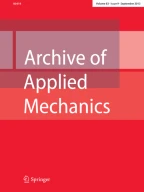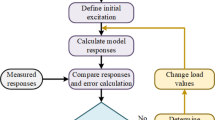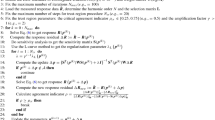The inverse identification problem and its technical application

This paper presents an overview of a loading force identification technique. Load identification methods are based on the solution of the inverse identification problem. Many different approaches for linear systems have been developed in this area. For both linear and nonlinear systems, methods based on the minimization of assumed objective functions are formulated. The least square error between the simulated and measured system responses is mainly used as the objective function. The dynamic programming optimization method formulated by Bellman is commonly used for the minimization of the objective function to estimate the excitation forces. The inverse identification problem in most practical cases is ill-posed because not all the state variables or initial conditions are known. Ill-posed inverse identification problems can be solved using several techniques, the most useful of which are: the generalized cross-validation method, the dynamic programming technique and Tikhonov’s method. This article presents the theoretical background and main limits to the application of inverse identification methods. Numerical and experimental tests on a laboratory rig were made to verify the formulated procedures. The method is applied to the identification of wheel–rail contact forces during rail vehicle operation. The method can be applied for indirect measurements of contact forces in railway equipment testing.
This is a preview of subscription content, log in via an institution to check access.
Access this article
Subscribe and save
Springer+ Basic
€32.70 /Month
- Get 10 units per month
- Download Article/Chapter or eBook
- 1 Unit = 1 Article or 1 Chapter
- Cancel anytime
Buy Now
Price includes VAT (France)
Instant access to the full article PDF.
Rent this article via DeepDyve
Similar content being viewed by others

Dynamic Load Identification for Mechanical Systems: A Review
Article 06 May 2021

Parameter Identification for Nonlinear Dynamic Systems via Multilinear Least Square Estimation
Chapter © 2014

Parameter identification of nonlinear structural systems through frequency response sensitivity analysis
Article 29 April 2021
Explore related subjects
References
- Allemang, R.J., Brown, D.L., Fludang, W.: Modal parameter estimation: unified matrix polynomial approach, Proceedings of the 12th IMAC, pp. 501–514 (1994)
- Anger G. (1990) Inverse problems in differential equations. Plenum, New York Google Scholar
- Bracciali A., Cascini G. (2000) Rolling contact force energy reconstruction, J. Sound Vib. 236(2): 185–192 ArticleGoogle Scholar
- Busby H.R., Trujillo D.M. (1986) Solution of an inverse dynamics problem using an eigenvalue reduction technique, Comput. Struct. 25(1):123–136 Google Scholar
- Cannon J.R., Hornung U. (1986) Inverse Problems. Birkhauser Verlag, Vauser MATHGoogle Scholar
- Chudzikiewicz A. (1991) Selected elements of the contact problems necessary for investigating the rail vehicle system. In: Kisilowski J., Knothe K. (eds) Advanced railway vehicle system dynamics. WNT, Warszawa Google Scholar
- Chudzikiewicz, A.: Elements of vehicle diagnostics, (in Polish) ITE, Radom (2002)
- Czop, P., Uhl, T.: Load identification methods based on parametric models for mechanical structures, In: 8th IEEE international conference on methods and models in automation and robotics, Szczecin, pp. 203–209 (2002)
- Dobson B.J., Rider E. (1990) A review of the indirect calculation of excitation forces from measured structural response data. J. Mech. Eng. Sci. 204, 69–75 Google Scholar
- Giergiel J., Uhl T. (1989) Identification of impact forces in mechanical systems. Arch. Mach. Des. 36(2–3): 321–336 Google Scholar
- Giergiel J., Uhl T. (1989) Identification of the input excitation forces in mechanical structures. Arch. Transp. 1(1): 8–24 Google Scholar
- Golub G.H., van Loan C.F. (1996) Matrix Computations. John Hopkins University Press, Baltimore MATHGoogle Scholar
- Góral, G., Zbydoń, K., Uhl, T.: Intelligent transducers of in-operational loads in construction fatigue monitoring. Mach. Dyn. Probl. 2–3, 73–88 (2002)
- Hadamard J. (1923) Lectures on Coughy’s Problem in Linear Partial Differential Equations. Yale University Press, New Haven Google Scholar
- Hansel E. (1991) Inverse Theory and Applications for Engineers. Prentice Hall, Englewood Cliffs Google Scholar
- Inoue H., Ishida K., Kishimoto T. Shibuya (1991) Measurements of impact load by using an inverse analysis technique. JSME Int. J. series I 34(4): 453–458 Google Scholar
- Kanehara, H., et al.: Study on online measurement of longitudinal creep force of railway vehicles, In: Proceedings of the conference J-Rail’98, November, Tokyo, pp. 457–469 (1998)
- Kanehara H., Fujioka T. (2002) Measuring rail/wheel contact points of running railway vehicles. Wear 253, 275–283 ArticleGoogle Scholar
- Lechowicz, S., Hunt, C.: Monitoring and managing wheel condition and loading. In: Proceeding of International Symposium for transportation recorders, Arlington, pp. 205–239 (1999)
- Li, J.: Application of mutual energy theorem for determining unknown force sources, Proceeding Of Internoise 88, Avignion, pp. 245–263 (1988)
- Liu G.R., Han X. (2003) Computational Inverse techniques in nondestructive evaluation. CRC Press, Boca Raton MATHGoogle Scholar
- Meirovitch L., Baruch H. (1982) Control of self-adjoint distributed-parameter systems. J. Guid. Control Dyn. 5, 60–66 ArticleMATHGoogle Scholar
- Mendrok, K.: Identification of loads in mechanical systems, Ph.D. Thesis, University of Science and Technology, Krakow (2003)
- Nielsen, J., Johansson, A.: Out of round railway wheels—literature survey, In: Proceedings Of the Institute of Mechanical Engineers – part F, vol. 214, pp. 79–91 (2002)
- Philips D.L. (1962) A technique for the numerical solution of certain equations of the first kind. J. ACM 9: 84–97 ArticleGoogle Scholar
- Simonian S.S. (1981) Inverse problems in structural dynamics. Int. J. Numer. Methods Eng. 17, 357–365 ArticleMATHMathSciNetGoogle Scholar
- Tikhonov A.N., Arsenin V.Y. (1977) Solution of Ill-Possed Problems. Winston and Sons, Washington, DC Google Scholar
- Trujillo D.M. (1987) Application of dynamic programming to the general inverse problem. Int. J. Numer. Methods Eng. 23, 613–624 Google Scholar
- Trujillo D.M., Busby H.R. (1997) Practical Inverse Engineering. CRC Press, London MATHGoogle Scholar
- Uhl T. (1998) Computer Assisted Identification of Mechanical Structures (in Polish). WNT, Warszawa Google Scholar
- Uhl T. (2002) Identification of loads in mechanical structures – helicopter case study Comput. Assist. Mech. Eng. Sci. 9, 151–160 MATHGoogle Scholar
- Uhl T., Pieczara J. (2003) Identification of operational loading forces for mechanical structures, Arch. Transp. 16(2): 109–126 Google Scholar
- Uhl T., Mendrok K. (2005) Inverse Identification Problems: Theory and Practical Applications (in Polish). ITE Press, Kraków Google Scholar
- Zhang, Q., Allemang, R.J., Brown, D.L.: Modal filter: concept and applications. In: Proceeding of 8th IMAC, pp. 487–496 (1990)
Author information
Authors and Affiliations
- University of Science and Technology, Krakow, Poland Tadeusz Uhl
- Tadeusz Uhl



